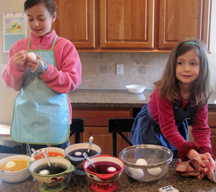 |
How to Dye Eggs Naturally
 What you'll need: What you'll need:
- A variety of eggs, washed and dried
- Foods for dyeing (Here are some ideas but don't be afraid to experiment: blueberries, spinach, tumeric, onions, beets, cranberries, paprika, lemon peels)
- Cardboard egg crate, wire rack, or shoe box lid with silver dollar sized holes (for
- drying eggs)
- 4 cups of water
- 2 tbsp of white vinegar
- Pots for cooking
- Strainer (for cold dyeing method)
- Beeswax crayons or rubber bands
- Tongs or slotted spoon
Dyeing Methods
Hot method. Combine uncooked eggs and ingredients for a single color in a large pot. Bring to a boil, then simmer for at least � hour (for deeper colors, simmer longer). Remove with tongs, pat dry, and place in a crate or on a rack or box lid.
Once dry, rub with vegetable oil for a shine or leave with a matte finish.
Cold method. (Safer for younger children.) Boil eggs. Avoid overcooking so shells remain intact. Next, mix dye ingredients, boil, and simmer as above. Remove dye from heat, cool and strain, reserving dye in bowl. Carefully place hard-boiled eggs in dye and leave in for at least � hour (or longer for deeper color). Remove with tongs, pat dry, and place in a crate or on a rack or box lid. Once dry, rub with vegetable oil for a shine or leave with a matte finish.
You can create a variety of colors with a few ingredients by dyeing some eggs with the hot method, some with the cold, and varying the amount of time eggs are exposed to the dye.
And here's a video with a very cool way to dye eggs using some left over tissue paper:
|
 |
